MI5 marks Armistice Day 2022
Published date: 11 Nov 2022
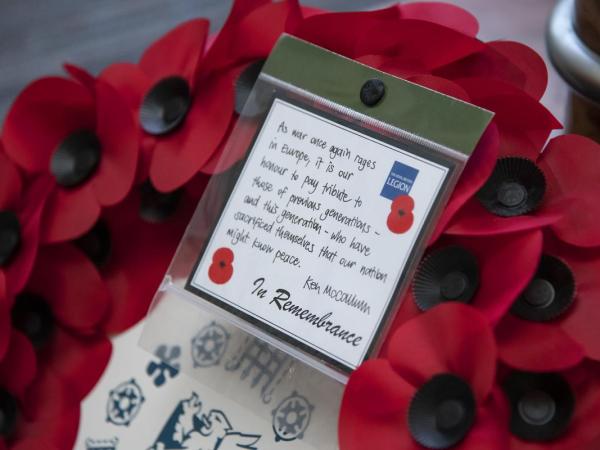
Staff at MI5 have today joined people around the UK to remember the sacrifice of those who lost their lives protecting this country and its allies.
Director General Ken McCallum led the short service of remembrance at Thames House, MI5’s London headquarters. The service was broadcast digitally for staff, who could also pay their own personal tributes on a virtual ‘Wall of Remembrance.’
Ken McCallum said: “Today we honour those who have fallen through the generations for the protection of the United Kingdom and its allies. Amid the horror of Russia’s invasion of Ukraine, it is right we take a moment to reflect on conflict past and present.”
MI5 was active during both the First and Second World Wars, playing a key role in combating espionage, intercepting communications, and feeding back disinformation.
This included double-cross operations in advance of the D-Day landings, which convinced the enemy that the landings would take place at Calais rather than Normandy.
Her Majesty The Queen and MI5
Published date: 17 Sep 2022
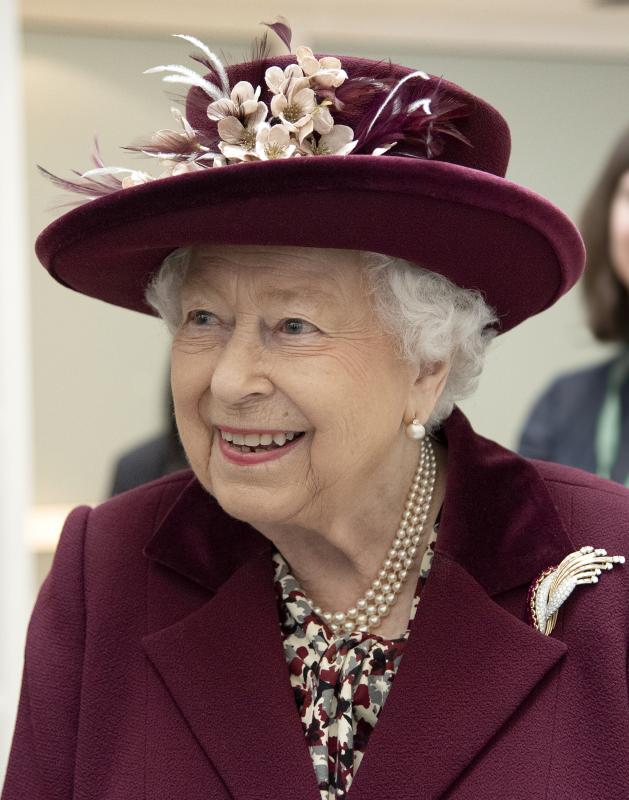
The Queen meeting staff on her last visit to Thames House in 2020
As the country mourns the death of Her Majesty The Queen, we reflect on the close relationship enjoyed between The Queen and MI5 during her long reign.
As crown servants, our motto ‘Regnum Defende’ (Defence of the Realm) embodies the long history between the Royal Family and our organisation.
The Monarch is also represented by the crown at the top of the portcullis on our crest, which Her Majesty gave her approval for us to carry on our official flag in 1981.
Thames House
The Queen visited Thames House in 1992 and 2007 and her final visit to our headquarters was in February 2020, when she met a significant number of our staff from all grades, received a briefing on threats and visited our private museum.
During an address to MI5 staff, The Queen said: “I have been impressed by the way that you have adapted to the changing threats of our nation… I am always struck by the remarkable resolve with which you carry out your vital role”.
A member of staff commented afterwards that “it was humbling to see her genuine interest in the nature of our work”.
HRH King Charles III has been patron of the Intelligence Services since 2011, and Prince William spent a week working alongside MI5 officers in 2019 as a continuation of the interest and support that the Royal Family has shown in our work.
MI5's work during Her Majesty’s reign

Former Director General Dame Stella Rimington greeting The Queen in 1992
In the course of her reign, which began on 6 February 1952, the Queen oversaw 15 Directors General of MI5.
During that time, there was a significant shift in the types of threats faced by the country, and the ways in which MI5 responded.
At the time of the Queen’s coronation, early in the Cold War years, the main focus of MI5’s work was countering Soviet espionage.
Following the end of the Cold War, MI5’s priorities became the domestic terrorist threat from the IRA and state-sponsored threats from overseas.
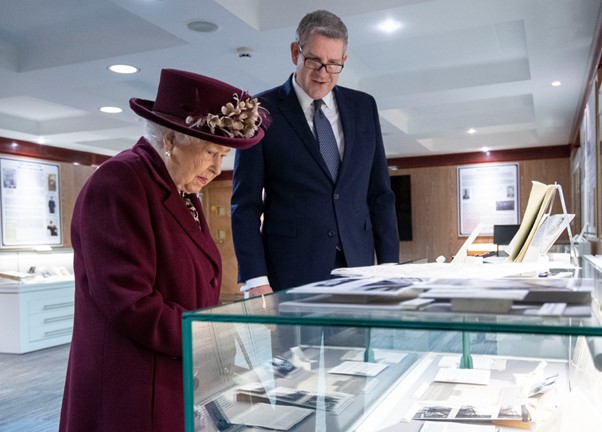
The Queen visiting the MI5 Museum in Thames House with former Director General Sir Andrew Parker
Christopher Andrew, in his authorised history of MI5 ‘Defence of the Realm’ noted that a small explosion at a power station in Shetland in 1981, caused by the IRA, failed to derail The Queen’s opening of an oil terminal just yards away, and described Her Majesty as “characteristically unruffled by the incident”.
We were privileged to benefit from The Queen’s private and public support and join the nation in this period of mourning.
MI5 remembers: Armistice Day 2021
Published date: 11 Nov 2021
Today, MI5 will be joining people around the UK to remember the service and sacrifice of all those that have defended our freedoms and protected our way of life.
As we join the national two-minute silence, we will be paying tribute to members of the Armed Forces, and their families, from Britain and the Commonwealth, reflecting on the vital role played by the emergency services and remembering those that have lost their lives as a result of conflict or terrorism.
We will be holding a short Remembrance Day service in Thames House, our headquarters, with members of staff who are currently serving in the Armed Forces Reserves laying wreaths. The service will be broadcast digitally for our staff and, as we did last year, we have established a virtual ‘Wall of Remembrance’, for colleagues to pay their own personal tributes.
MI5 was active during both the First and Second World Wars, playing a key role in combating espionage, intercepting communications, and feeding back disinformation. This included double-cross operations in advance of the D-Day landings, which convinced the enemy that the landings would take place at Calais rather than Normandy. You can find out more about our work in support of the Allied effort in both World Wars here.
MI5 marks 20th anniversary of 9/11
Published date: 10 Sep 2021
As we approach the 20th anniversary of the appalling terror attacks against the United States on September 11th 2001, our thoughts are with all of those who lost their lives and those whose lives were forever changed by the tragic events that unfolded. We also pay tribute to those first responders who risked, and in some cases sacrificed, their own lives to rescue others in the aftermath.
The events of 9/11 left a lasting impression on a generation, shaped the course of world events for years to come and changed the nature of the terrorist threat facing the UK and our allies. The scenes broadcast to the world that day had a profound and enduring effect on those working for MI5, who found themselves facing a threat of unparalleled scale.
Speaking on Radio 4’s Today programme today, Friday, 10 September 2021, MI5 Director General Ken McCallum shared his own personal reflections about the events of that day:
“On 9/11 I’d been in MI5 for five years as an agent runner, working with human sources inside terrorist organisations in Nothern Ireland. On the morning of 9/11 when the first plan struck the Twin Towers we turned on the television in the corner of a room and as the second plane struck, a colleague quietly said ‘Osama Bin Laden’ . Someone else said ‘I guess we all know what we are doing for the next 10 years of our lives' – and so it proved. In the 20 years since, we have faced wave after wave of terrorism from extremists seeking to cause mass causalities, prepared to give up their own lives in the act. That is a horrifying reality but it is also, by the same token, a very motivating mission for my organisation."
To pay our respects, we are flying the UK and US flags alongside each other in the entrance of Thames House, our London HQ.
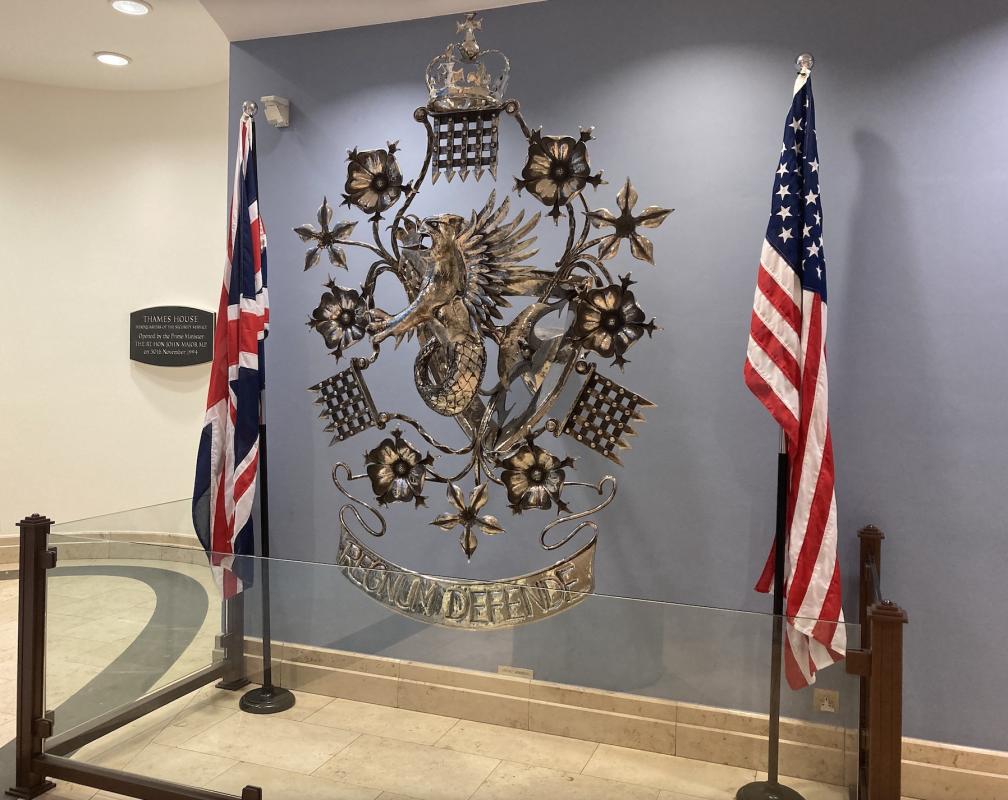
MI5 remembers: Armistice Day 2020
Published date: 11 Nov 2020
Today, MI5 will be joining people around the UK to remember those who lost their lives whilst protecting our country. We will be joining the national two-minute silence and reflecting on the sacrifice of those men and women who were killed, or whose lives were changed irrevocably by war.
We have historically held a Remembrance Day service in Thames House, our headquarters, and whilst that will not be possible this year, we will be holding a short virtual event for our staff and have established a virtual ‘Wall of Remembrance’, for colleagues to pay their personal tributes.
MI5 was active during both the First and Second World Wars, playing a key role in combating espionage, intercepting communications and feeding back disinformation. This included double-cross operations in advance of the D-Day landings, which convinced the enemy that the landings would take place at Calais rather than Normandy. You can find out more about our work in support of the Allied effort in both World Wars here.
MI5 commemorates VE Day 75
Published date: 07 May 2020
Friday 8 May 2020 marks the 75th anniversary of Victory in Europe (VE) Day. Like the rest of the country, MI5 pays tribute to the service and sacrifice of the entire Second World War generation, from British, Commonwealth and Allied Forces to evacuees and those on the Home Front. Our Headquarters will be flying the Union flag at full mast to mark the occasion, and the organisation will join the country in a two minute silence at 11am.
During World War II, MI5 played a key role in combating enemy espionage, intercepting German communications and feeding misinformation back to Germany.
The organisation achieved great success in uncovering enemy agents in Britain, some of whom were "turned" by the Service and became double agents who fed false information to the Germans about military strategy throughout the war.
When German intelligence records were studied after the end of the war in 1945, it was found that almost all of the further 115 or so agents targeted against Britain during the war had been successfully identified and caught.
On the last Sunday of the war, church bells near Blenheim Palace (where most of the Service was based) rang out. Staff were allowed onto the Palace’s terrace to listen to the bells and people recalled it as being a “tremendous occasion”.
You can read more about MI5’s work during the Second World War here.
International Women's Day: MI5's first female agent runner
Published date: 06 Mar 2020
MI5 staff have been celebrating International Women's Day 2020 with a series of social events, panel conferences and inspirational talks to staff, leading up to Sunday 8 March. One of the talks focussed on the history of women at MI5. We wanted to share one of the many fascinating stories of women who have helped shape our history: Mary Sherer - MI5's first female agent runner.
Mary Sherer joined MI5 in 1936 as a secretary at the age of 21. After a posting as a PA in Malta, she returned to London on the outbreak of war as assistant to Lord Rothschild, the nation's leading authority on German and Italian sabotage methods. Sherer was subsequently promoted to desk officer, and in 1942 was posted to Washington as an adviser on sabotage to the Head of British Intelligence and Security in North America.

(Mary Sherer)
On her return to London the following year, Sherer joined the section responsible for turning German agents back against the Abwehr (the German Military Intelligence Service), known as Double Cross. She had sole responsibility for the agent known as TREASURE, a French national and talented artist named Lily Sergeyev, who had volunteered her services to the Germans with the intention of double crossing them. After the Abwehr took up her offer, she contacted the British Embassy in Madrid and was flown to London, where she was debriefed, and soon after recruited by Sherer, who was convinced that TREASURE would be a successful double agent.
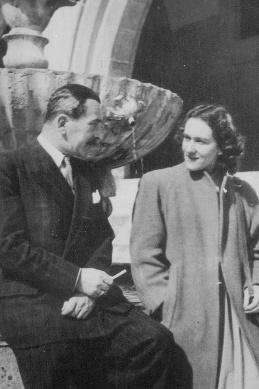
(TREASURE with her German handler)
TREASURE worked under Sherer's direction as a deception agent, feeding a mixture of bogus and genuine information back to Germany, and they spent many hours carefully crafting the text of TREASURE's messages back to her handlers. However, the relationship was not without its difficultes. TREASURE had left her beloved dog, Babs, in Gibraltar due to British quarantine rules, but was intent on bringing Babs to the United Kingdom. In 1943, she told Sherer she would refuse to send any further messages to the Abwehr until they had been reunited. TREASURE relented a few months later and restarted communication with the Germans, but the situation deteriorated again when the unfortunate Babs died in Gibraltar, a few weeks before D-Day. TREASURE confessed to Sherer that she had hatched a plan to wreak revenge on the British for Babs' death by warning her German handlers via a code that she could insert in her transmissions to indicate that she had been compromised, but would not tell Sherer what the code was.

(Babs)
The Double Cross deception, designed to mislead the Germans on the D-Day landing locations, was reliant on TREASURE continuing to send bogus messages to her German handlers. In light of TREASURE's confession, Sherer was faced with a major dilemma: pull the plug on TREASURE's communications with the Abwehr and risk the Germans becoming suspicious, or continue with the risk that TREASURE might insert a code to warn them in future messages. The decision was taken to keep TREASURE in play, and her communications contributed towards the successful D-Day Double Cross deception. Shortly afterwards, TREASURE was discontinued as an agent, and returned to France later in 1944. Before she left, Sherer managed to get TREASURE to reveal what the warning code would have been to the Germans. She then checked every message that had been sent to the Abwehr, and confirmed that TREASURE had never used it.
Sherer was highly commended for her contribution to the success of Double Cross but, as a woman, she was never given officer rank alongside her male counterparts. She chose to leave MI5 after the war and moved to Rome with Phyllis McKenzie, who had worked for British Intelligence in New York during the war, where they opened a bookshop.
Mary Sherer was just one of many inspirational women who have done exceptional work to protect national security in MI5's history. Today, we strive to foster an environment at MI5 where everyone can achieve their potential, and are celebrated for their successes, irrespective of their gender.
ITV documentary - 'Inside MI5'
Published date: 27 Feb 2020
The documentary showing what life is like for those who work at MI5 was first shown on Thursday 27 February on ITV1. Over the course of three months, a small team at ITV were given controlled access to our headquarters at Thames House to provide an insight into the people who work behind the scenes to keep the country safe.
The staff members, who have their identities protected, describe what they do, how they do it, and what it feels like to work for MI5.
Speaking to ITV News, Director General Sir Andrew Parker explained why he had ageed to allow cameras into our otherwise secret organisation:
"MI5 exists to serve and protect the public and this country, so where it's possible for us to explain a bit more about ourselves, we'd like to do that. I think it's helpful if the public can see a bit more about what we're like as people, and the human side of MI5".
'Inside MI5: Keeping the UK safe' is available to view on ITV Hub. You can watch clips from the programme here:
https://www.itv.com/news/topic/inside-mi5/

MI5 remembers: Armistice Day 2019
Published date: 11 Nov 2019
MI5 today joined the country in a two minute silence to mark Armistice Day and remember the sacrifice of those who have lost their lives to protect our country. A Remembrance Day service was held at Thames House, MI5’s headquarters, to provide staff with an opportunity to pay their respects, with a wreath laid at MI5’s poppy memorial.
Yesterday (Sunday, 10 November) MI5 Director General Andrew Parker joined veterans, serving armed forces personnel, Government representatives and the Royal Family at the National Service of Remembrance at the Cenotaph. In advance of the service, he also attended a small reception for veterans hosted by the Prime Minister at 10 Downing Street.
Earlier this year, the Royal British Legion announced that the symbol of the red poppy will now represent a tribute to civilian victims of war and acts of terrorism, along with the UK’s armed forces.
MI5 marks the 30th anniversary of the fall of the Berlin wall
Published date: 06 Nov 2019
On 9th November 1989 the Berlin Wall fell - one in a series of monumental events that went on to transform Europe, and also the work of MI5.
The wall had been put up in August 1961 to stem the massive flow of refugees from East to West Germany after Germany was divided into two separate countries in 1949. This outpouring represented a great loss of prestige for the East German regime, as well as an enormous economic loss: many of those fleeing west were scientists, engineers and doctors. The barbed wire and fences went up along the border overnight on 12 August, meaning people were stuck on whichever side they had gone to bed on that night.
The fall began on the evening of 9 November after mass demonstrations in East Berlin resulted in the East German government announcing that all its borders would be opened. People soon took matters into their own hands and started to break through the wall in other areas with whatever implements they had to hand, before the Mauerspechte - Wall Woodpeckers - went to work on the official demolition, to the cheers of crowds of onlookers.
What was the impact on MI5?
The collapse of the Soviet bloc and Soviet Union itself led to the end of the Cold War, and a resultant decline in the threat from subversion and espionage. This coincided with a shift in the domestic and global terrorist landscape, meaning MI5's focus shifted increasingly towards counter-terrorism rather than counter-espionage and counter-intelligence. The bombing of Pan-Am flight 103 over Lockerbie in Scotland - still the highest-casualty terrorist attack in the UK - had taken place less than a year before, and the Provisional Irish Republican Army (PIRA) was well-armed thanks to significant shipments of weaponry from Libya during the 1980s. These and other areas of counter-terrorism work, including the ongoing hostage crisis in Lebanon, demanded a significant MI5 investigative response.
The peace dividend arising from the end of the Cold War, and the escalating pace of the threat from Northern-Ireland Related Terrorism, led to an expansion in our remit, with MI5 taking on the national lead for investigating Irish Republican terrorism on the UK mainland for the first time.
In the years that followed, MI5 also played an important role in supporting the development of the fledgling security and intelligence services in the emerging democracies of Eastern Europe.
Today, very little of the wall is left. Just three sections remain standing: a 90m piece at the site of the former Gestapo HQ, halfway between Checkpoint Charlie and Potsdamer Platz, another section along the river Spree near Oberbaun Bridge and a third at a site in Bernauer Strasse, which was turned into a memorial in 1999. Those parts which do remain are a stark reminder of the Cold War years - an incredibly challenging and important period in MI5's history - and the turning point which its destruction marked.